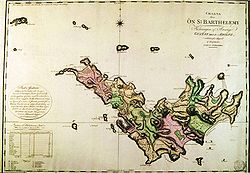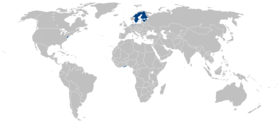Swedish colony of Saint Barthélemy
| Saint Barthélemy | ||||||||||
| Barthélemy | ||||||||||
| Swedish colony | ||||||||||
|
||||||||||
|
Swedish map of Saint Bartélemy, late 18th century.
|
||||||||||
|
Map of Sweden Overseas Territories and Territorial Entities.
|
||||||||||
| Capital | Gustavia | |||||||||
| Languages | Swedish, French, English | |||||||||
| Political structure | Colony | |||||||||
| King | ||||||||||
| • | 1784–1792 | Gustav III (first) | ||||||||
| • | 1872–1878 | Oscar II (last) | ||||||||
| Governor | ||||||||||
| • | 1785–1787 | Salomon von Rajalin (first) | ||||||||
| • | 1868–1878 | Bror Ludvig Ulrich (last) | ||||||||
| Historical era | Swedish colonization of the Americas | |||||||||
| • | Exchanged with Sweden | 1 July 1784 | ||||||||
| • | Sold back to France | 16 March 1878 | ||||||||
| Area | ||||||||||
| • | 1878 | 21.24 km² (8 sq mi) | ||||||||
| Population | ||||||||||
| • | 1800 est. | 5,000 | ||||||||
| • | 1863 est. | 2,834 | ||||||||
| • | 1875 est. | 2,374 | ||||||||
|
||||||||||
| b. | ... | |||||||||
The Swedish colony of Saint Barthélemy existed for a period of 94 years from the late 18th century. In 1784, one of Louis XVI's ministers ceded the French Caribbean island to Sweden in exchange for trading rights in the Swedish port of Gothenburg. Swedish rule lasted until 1878 when the French repurchased the island.
Following problems experienced by early French settlers, Saint Barthélemy was successfully colonized by French mariners in 1763. Attracted by the island's prosperity during the American Revolutionary War, Gustav III of Sweden agreed to exchange French trading rights in Gothenburg against Swedish colonization of the island. In addition to its fresh water sources, the island produced moderate amounts of cotton, sugar, cocoa, tobacco and fruits while it promised substantial revenue from trade through its natural harbour on the island's west coast.
On 1 July 1784, the island became a Swedish possession. The king informed Sweden's privy council of the acquisition on 23 August. On 1 September, Swedish officials under the leadership of Salomon von Rajalin (1757–1825), the island's first Swedish governor, were appointed to administer the island. They sailed from Gothenburg on 4 December 1784 on the frigate Sprengtporten, arriving in Saint Barthélemy on 6 March 1785. In January 1785, the Swedish merchants Jacob Röhl and Adolf Fredrik Hansen had already arrived to establish a trading post with warehousing. At the time, the island had a population of some 750 of whom 281 were slaves. French was spoken in the rural areas while English was spoken in the capital.
On 7 March 1785, the French commandant Chevalier de Durant ceded authority to von Rajalin who, on 16 April 1785, introduced tax free trading for visiting ships. On 7 September, he established Saint Barthélemy as a free port. The French port of La Carénage was renamed Gustavia after the Swedish king.
From 28 August 1786, slave trade was included in a royal letter and on 12 March 1790 the taxation regime for the shipment of slaves was established. Between a third to half of Saint Barthélemy's population were registered slaves in year 1819 (estimations are between 1,283 and 2033 slaves). On 31 October 1786, the Swedish West India Company was established on the island with responsibility for maintaining the port and the employment of Swedish officials. By the end of the century, around 1,330 ships visited the port of Gustavia annually.
...
Wikipedia


